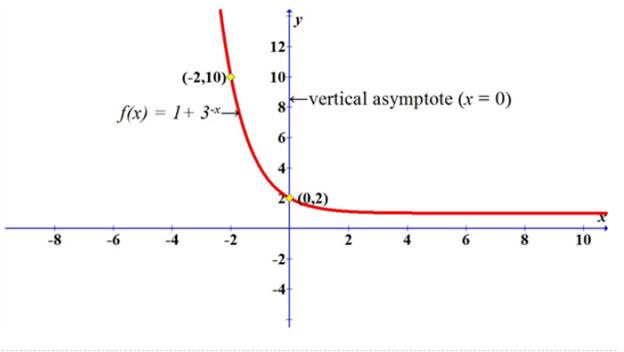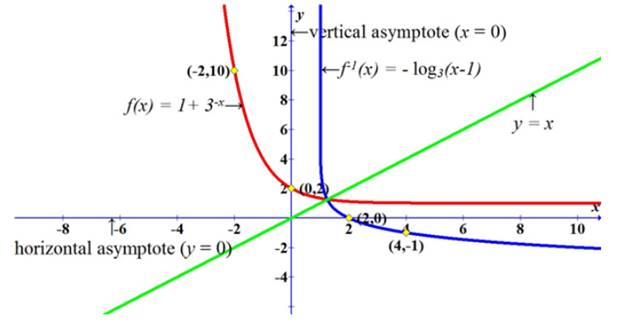
(a)
To Find: The domain of the
(a)
Answer to Problem 58RE
The domain of the function is
Explanation of Solution
Given:
The given function is
Calculation:
Consider the given function is,
The function is defined for all the value of
(b)
To Find: The graph for the function
(b)
Explanation of Solution
Given:
The given function is
Calculation:
The graph for the given function is shown in Figure 1

Figure 1
(c)
To Find: The range and the asymptote of the graph.
(c)
Answer to Problem 58RE
The range of the function is,
Explanation of Solution
Given:
The given function is
Calculation:
Consider the given function,
The range of the above function is the set of all the real numbers that is,
Thus, the verticalasymptotes of the given function is,
(d)
To Find: The function
(d)
Answer to Problem 58RE
The inverse of the functions is
Explanation of Solution
Given:
The given function is
Calculation:
Consider the given function,
Then,
Then, the inverse of the function is,
Take the log of both the sides and solve as,
(e)
To Find: The range of the function.
(e)
Answer to Problem 58RE
The range of the function is
Explanation of Solution
Given:
The given function is
Calculation:
Consider the given function,
The domain of the function
(f)
To Find: The graph of the function
(f)
Explanation of Solution
Given:
The inverse of the function is
Calculation:
The graph for the inverse of the function is shown in Figure 2

Figure 2
Chapter 5 Solutions
Precalculus
Additional Math Textbook Solutions
Introductory Statistics
Thinking Mathematically (6th Edition)
Precalculus
University Calculus: Early Transcendentals (4th Edition)
College Algebra (7th Edition)
Calculus for Business, Economics, Life Sciences, and Social Sciences (14th Edition)
- The graph of f' is below. Use it to determine where the local minima and maxima for f are. If there are multiple answers, separate with commas. 2 f'(x) N -5 -4 3-2-1 -1 -2 -3 -4 12 3 4 5 -x Local minima at x Local maxima at xarrow_forwardThe graph of f' is below. Use it to determine the intervals where f is increasing. -5-4-32 4- 3 2 1 -2 -3 +x 2 3 4 5arrow_forwardThe graph of f' is below. Use it to determine where the inflection points are and the intervals where f is concave up and concave down. If there are multiple inflection points, separate with a comma. 6 5 4 3 2 1 f'(x) +x -6-5-4-3 -2 -1 1 2 3 4 5 6 -1 -2 -3 -4 -5 -6+ Inflection point(s) at x = Concave up: Concave down:arrow_forward
- The graph of f' is below. Use it to determine where the local minima and maxima for f are. If there are multiple answers, separate with commas. f'(x) 4- -5-4-3-8-1 3 2 1 x 1 2 3 4 5 -1 -2 -3 -4 Local minima at a Local maxima at =arrow_forwardThe graph of f' is below. Use it to determine the intervals where f is increasing. f'(xx) 4- -5 -3 -2 3 2 1 1 2 3 4 5 Cit +x 7 2arrow_forwardPlease focus on problem ii.arrow_forward
 Calculus: Early TranscendentalsCalculusISBN:9781285741550Author:James StewartPublisher:Cengage Learning
Calculus: Early TranscendentalsCalculusISBN:9781285741550Author:James StewartPublisher:Cengage Learning Thomas' Calculus (14th Edition)CalculusISBN:9780134438986Author:Joel R. Hass, Christopher E. Heil, Maurice D. WeirPublisher:PEARSON
Thomas' Calculus (14th Edition)CalculusISBN:9780134438986Author:Joel R. Hass, Christopher E. Heil, Maurice D. WeirPublisher:PEARSON Calculus: Early Transcendentals (3rd Edition)CalculusISBN:9780134763644Author:William L. Briggs, Lyle Cochran, Bernard Gillett, Eric SchulzPublisher:PEARSON
Calculus: Early Transcendentals (3rd Edition)CalculusISBN:9780134763644Author:William L. Briggs, Lyle Cochran, Bernard Gillett, Eric SchulzPublisher:PEARSON Calculus: Early TranscendentalsCalculusISBN:9781319050740Author:Jon Rogawski, Colin Adams, Robert FranzosaPublisher:W. H. Freeman
Calculus: Early TranscendentalsCalculusISBN:9781319050740Author:Jon Rogawski, Colin Adams, Robert FranzosaPublisher:W. H. Freeman
 Calculus: Early Transcendental FunctionsCalculusISBN:9781337552516Author:Ron Larson, Bruce H. EdwardsPublisher:Cengage Learning
Calculus: Early Transcendental FunctionsCalculusISBN:9781337552516Author:Ron Larson, Bruce H. EdwardsPublisher:Cengage Learning





